Perhaps the most terrifying critter to find in your yard isn’t a wolf or a bear, it’s the adorable little skunk. Skunks (and their close relatives, the stink badger) have a nasty reputation due to their ability to spray you with a sticky stench that can take days to remove and may have you sleeping on the porch.
But there’s a lot to learn about these critters, and getting rid of skunks may be both easier and more difficult than you think.
Getting to Know Skunks
Skunks are a fascinating critter that can be found in many parts of the world. Most people only know them for their trademark skunk smell, but there’s a lot more to these little guys than meets the eye.
Types of Skunk
There are actually several different types of skunk, many of which can be found in the US and other parts of North America. The following species may all be found in the US:
American Hog-Nosed Skunk (Conepatus leuconotus)
This species has a single wide stripe and a pig-like tip to their snout. They can be found throughout Texas and Mexico, spreading into several Southwestern states as well as Central America.
Eastern Spotted Skunk (Spilogale putorius)
Found mainly in central and eastern US states, this skunk has multiple broken stripes that run both vertically and horizontally along its body. They’re far more active than most other skunk species and great climbers.
Hooded Skunk (Mephitis macroura)
This skunk is one of only two species in the Mephitis genera. It’s found mostly in Mexico and Central America, but extends into Arizona, New Mexico, and parts of Texas. They tend to be almost entirely black or have up to two stripes.
Striped Skunk (Mephitis mephitis)
When someone mentions skunk, this is probably the image that comes to mind. The iconic two white stripes and tapered nose of this species can be spotted throughout the US.
Western Spotted Skunk (Spilogale gracilis)
Found throughout the western states and into Mexico and a small portion of Canada, the western spotted skunk has multiple stripes running in more than one direction, making them appear mottled. They have a shorter firing range, but more pungent musk than striped skunks.
Skunk Habitat
Skunks have a wide range of natural habitats, but tend to avoid densely packed forests and wetlands. You will often find them in meadows, open forests, prairies, and some even enjoy canyons and other rocky terrain.
Breaking the Myths of Skunk Appearance
There are a few myths about skunks that regularly make their rounds. Of these, identification is one of the biggest myths. Here are a couple important myth busters:
Myth: Skunks are black and white.
Truth: While this is a common color combination, skunks can also be brown, cream, albino, red, and even lavender. Some species have mottled fur or other markings. Additionally, a skunk’s fur may change colors as it gets older.
Myth: The number of stripes denotes the sex.
Truth: Male and female skunks can have the same number, size, and shape of stripes. In many cases, skunks within the same litter end up with very different coloration and markings from one another as they get older.
Where Do Skunks Go During the Day? All About Dens
Skunks are crepuscular (dusk and dawn) scavengers and usually spend days in the safety of their den. This den is sometimes located in thickets or other sheltered areas above ground during the summer.
In winter, a skunk will line their underground burrow with leaves and grass for insulation and rarely leave. Winter is also the only time skunks tend to enjoy being in the company of one another, with several sharing the same den for greater warmth.
What Do Skunks Eat?
Skunks are omnivores and excellent scavengers. Their preferred foods are grubs, crickets, beetles, grasshoppers, and other various insects and their larvae. They’ve developed surprisingly good digging skills as a result.
However, in the absence of insects, they’ll eat roughage, small critters such as mice, rats, moles, lizards, frogs, snakes, and birds. They are also known to raid your garbage or outdoor pet food bowls.
Why Do Skunks Smell So Bad?
This is actually a defense mechanism, not the skunk itself. Skunks produce a strong musk that vaguely resembles the smell of burning rubber. Some of this musk gets into the skunk’s fur, giving it an odor that is meant to ward off predators. However, a freshly bathed skunk will lose that smell temporarily.
The musk is produced in a heavily concentrated form in the skunk’s anal glands. These glands are similar to the ones in dogs and can serve a similar purpose. Pet skunks have the glands removed, which is why they lack the strong smell of their wild kin.
How Skunks Protect Themselves?
Everyone knows about skunk spray, but that’s actually the last resort weapon, as the glands contain a limited amount of fluid. Once depleted it can take about a week for the skunk to refill. Here are some other defenses in a skunk’s surprising arsenal:
Marking and Musk: As mentioned earlier, skunks don’t just spray their musk. They mark territory like any other wild animal. The musk also gets into their fur, creating an early warning for potential predators.
Tooth and Claw: Skunks have digging claws, much like a dog. However, they’re a bit sharper and can still do a bit of damage in a pinch. Meanwhile, their teeth allow them to give a vicious bite when necessary.
The Glands: Skunks will hiss, stomp, and do a handstand in warning. If none of these work, it’ll plant its feet and express its anal glands into the face of an attacker. The spray is designed to retain its smell for up to a week (sometimes longer).
It can be detected up to half a mile away, and temporarily causes eye irritation to reduce the attacker’s ability to strike.
All to Bear: Anyone who’s had a pet skunk might have noticed how flexible they are, especially when playing. Skunks can fold their body in half, bringing their teeth, claws, and gland to face in the same direction.
How Far Can a Skunk Spray?
This can depend a bit on the skunk. Most adult skunks can shoot up to 10 feet with deadly accuracy. However, there have been documented cases of 15 feet and a few even reaching 20 feet.
Of course, the spray can go further than this, but the accuracy is greatly reduced.
Skunks and Humans
Native Americans have many legends about skunks, in which the skunk is usually portrayed as an antagonist whose once-deadly spray has been rendered harmless by the hero.
When Europeans first encountered them, they had a much different take, calling them American polecats because they resemble the European polecat.
He’s portrayed as a French skunk who inevitably falls in love with Penelope the black cat after the latter has an accident that gives her stripes. Each episode follows Penelope as she tries to avoid the lovestruck skunk’s advances. The tables usually turn at the end, with a lovestruck Penelope chasing the now terrified Pepe.
Are Skunks Dangerous?
Generally speaking, skunks aren’t overly dangerous, and their musk has no long-term effects.
However, skunks (like bats, raccoons, and many other critters) are susceptible to rabies. Luckily, it’s at a much lower rate than the aforementioned species due to the way most critters will avoid attacking them.
Just to be safe, you should never approach a wild skunk if it can be avoided.
Can Skunks Be Kept as Pets?
Depending on the state you live in, the answer is a resounding yes! Skunks resemble a cross between cats and ferrets in temperament and are extremely affectionate.
Be warned, skunks can slip leashes and should never be left on a harness unsupervised, as a skunk that gets loose outdoors rarely comes back and is easy prey for predators.
There’s some maintenance involved, as skunks have a different dietary requirement than cats and dogs, and need lower protein. However, if your cat or dog is an indoor pet, they’ll get along fine (semi outdoor pets tend to know the dangers of skunks and will try to avoid one).
Skunks love water, and can be bathed weekly in a natural product such as Mane & Tail to eliminate any musk smell, as long as you’re there to make sure there’s no risk of drowning.
To get a pet skunk requires some hurdles, as they’re considered an exotic species. Find out if your state permits owning one and any specific regulations. Note than most states don’t permit the transport of skunks across state lines.
You will need to get a license (most state-licensed breeders are able to issue one) and by law, the skunk is de-sacked at four weeks (this is usually covered in the adoption fee). Finally, you should get your skunk spayed or neutered.
Female skunks go through a very rough heat cycle that can cause lasting damage, reducing their lifespan; while males will start urine marking. A pet skunk that has been spayed/neutered can live as long as 20 years. Conversely, a mother skunk often only lives around two to three years.
Benefits of Skunks
Skunks are actually highly beneficial, despite their habit of getting into trouble. One of the biggest benefits is the fact that they hunt mice and other small rodents. They can be just as efficient as a cat, perhaps even more so thanks to their ability to squeeze into tight spaces.
They also go after insects and can be a valuable ally against many forms of infestation. They’re especially keen on going after slugs, snails, and Japanese beetles. However, it might not be a good idea to let one loose in your garden, since they’re excellent diggers.
Why Skunks Become a Nuisance
Because skunks are skilled foragers, they tend to live by their noses. This will lead them to your garden, where there’s plenty of food – both bugs and vegetation.
Your yard could end up looking like a compressed golf course if you have a grub problem. These shallow holes and the scent of skunk musk are the two biggest reasons they’re considered nuisance animals.
Of course, they’ll also explore your trash if the opportunity arises or steal food from outdoor pets. Some have even been known to kill chickens while scavenging for their eggs. And, of course, there’s always the risk of a startled skunk spraying a family member.
Can Skunks Jump or Climb Fences (or Trees)?
Officially, the only species confirmed to climb trees is the eastern spotted skunk, which can do so with ease. A three foot fence is usually tall enough to keep skunks out, although most skunks CAN climb up platforms and other large outcroppings within reach.
As most skunk pet owners will tell you, a skunk can climb stairs with some minor effort (and enough incentive), but have trouble with anything higher. Just be warned, they may not be able to go up, but they’re pros at going down, so extend those fences at least a foot below ground level.
See Also: Can Skunks Swim?
How to Get Rid of Skunks
The good news is, it’s not that difficult to get a skunk off of your property. It’s just as easy to discourage them from visiting in the first place, once you know what they’re after.
Spotting Signs of a Skunk
Despite what you may think, just checking for the smell of skunk musk isn’t enough to identify a skunk’s presence, especially during the day. Here are some common calling cards:
Droppings
Skunk poop is usually between one and two inches long and about half an inch wide. Spotting animal droppings of a similar size and shape are a good indicator that a skunk or similarly-sized critter is nearby.
See Also: What Does Possum Poop Look Like?
Grub Holes
One of the best telltales signs is actually grub holes. Skunks will dig a conical hole one to three inches deep looking for grubs to munch on.
Skunk Sounds
If you’re paying attention, skunks make a variety of sounds in many instances. They will hiss and growl when threatened but may also chirp, chatter, squeak, and even purr depending on their mood.
Skunk Tracks
You might be able to spot their five-toed, clawed tracks in the mud or snow. While similar to other critters, these tracks are still a good warning sign a skunk might be living nearby.
Skunk Dens
Identifying a skunk den is typically straightforward since skunks prefer making their dens in noticeable spots like under structures or in dug-out holes, and their pungent spray offers a strong scent clue.
However, concealed dens or properties with many potential hideaways can pose more difficulty. With some search effort and by following skunk signs, their dens may usually be found.
Will Skunks Leave on Their Own?
In the event they’ve set up home on your property for the winter, a skunk will usually leave in the summer once any kits have grown old enough to survive on their own. Thus, it may be best to just wait it out when you find skunks in the winter to late spring.
Just be sure there are no food sources or other incentives for them to stay, and take preventative measures to prevent future visits.
Evicting Skunks
The single best way to evict a skunk is to exclude it. Fence off your yard and leave one access point. You can install a temporary exclusion device, trap, or other one-way ticket.
Once you know the skunk has left, you can seal off the entry point more permanently. Just make sure the skunk didn’t leave behind any kits when you do.
Skunk Repellents
Sadly, skunks are one species where you can’t rely on a home remedy. Essential oils, cayenne pepper, and other common methods have little or no effect on a skunk. You can use a rag soaked in ammonia or predator urine crystals to chase a skunk from its den or parts of your yard temporarily, however.
More effective methods are to use a deterrent device, such as one that produces lights or loud noises when it detects motion. Avoid leaving a porch, patio, or garden light on, as these will attract insects and open a buffet for your striped adversary.
Skunks don’t like light, especially sudden bright lights, because their eyes are adapted for hunting in low light conditions. However, keep in mind skunks aren’t actually nocturnal, and can get used to constant lighting.
Trapping Skunks
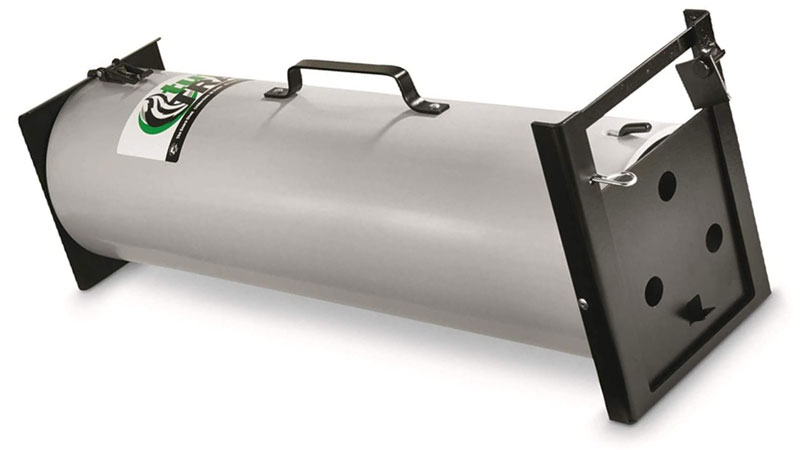
When simple exclusion isn’t an option, you can attempt to trap the skunk. Make sure it’s legal in your area before proceeding.
Trapping a skunk can be quite risky, as they will panic and may become aggressive, even if they aren’t rabid. The trapped skunk might bite, scratch, and/or spray.
Because of the skunk spray issue, normal small critter cage traps (ie: Havahart) aren’t the best idea. Instead, fully enclosed “skunk traps” by Tuff Trap or JT Eaton are the way to go.
Usually, when released, they will run for the nearest shelter. Also, the skunk must be released at least ten miles away to avoid them finding their way back.
It’s usually better to hire a professional instead of tackling a skunk on your own, and these experts have a license to trap skunks even in places where it may normally be illegal. If you’re worried about rabies or getting sprayed, this is probably your safest bet.
How to Keep Skunks Away
There are two things you can do to keep skunks away from your property. The first is the usual “closing the hotel” combination of removing attractions and blocking entrance points. The second is using repellents.
Closing the Hotel
Skunks are attracted to the usual suspects, i.e. food, water, and shelter. Eliminating these is will not only keep skunks from taking an interest in your property, it will also deter a lot of other critters.
A Good Fence
With the exception of the eastern spotted skunk, skunks are very poor climbers. Enclose your yard in a fence that extends at least three feet above ground and one foot or more below ground. Make sure there are no objects outside the fence a skunk can use as steps to reach the top of the fence.
Close the Buffet
Skunks will be attracted by three major food sources: bug/rodent infestations, the garden, and trash. Work on finding and eliminating any infestations on your property, as well as incorporating some preventative maintenance to avoid future infestations.
Remember, critters such as grasshoppers are tasty treat for a skunk and a hungry skunk will stop at nothing to get at a good food source. Be sure to regularly treat your lawn or backyard for grubs as well.
Finally, make sure any trash cans have secure, tight-fitting lids to prevent skunks or other critters from knocking them over and getting inside. Putting the cans on a raised surface serves as an effective, cheap skunk deterrent.
No Vacancy
Clear away any debris in the yard that the skunk might use for shelter or want to check for food sources. Close off any crawl spaces under your deck or shed using chicken wire, as these are excellent spots for skunks to build a den or nest in. Keep wood piles elevated and far from your house.
You will also want to check for and seal off any potential access points under your house. Just make sure there are no kits (baby skunks) in the space before sealing it off if you’re doing so in the spring or early summer.
- How to Get Rid of Hawks - March 8, 2024
- How to Get Rid of Pill Bugs (Rolly Pollies) - March 1, 2024
- How to Get Rid of Groundhogs (Woodchucks) - February 5, 2024

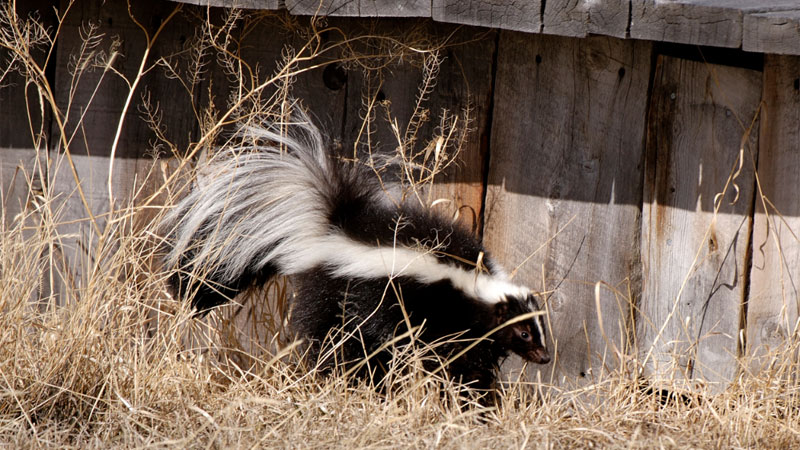
 Just tell me how to get rid of ’em.
Just tell me how to get rid of ’em.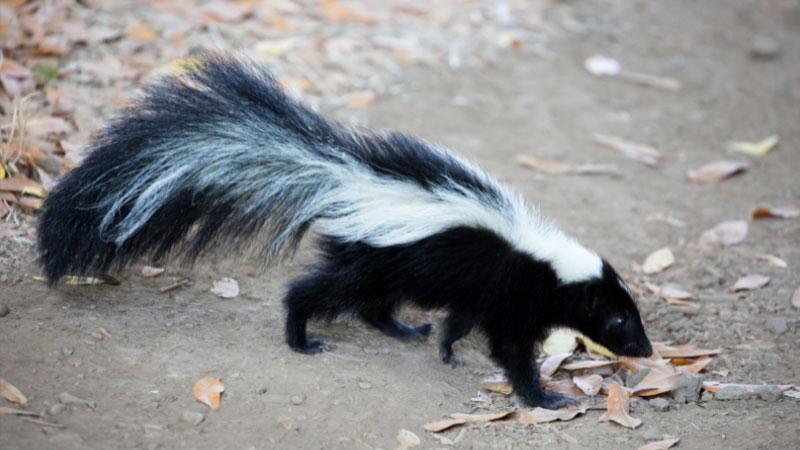
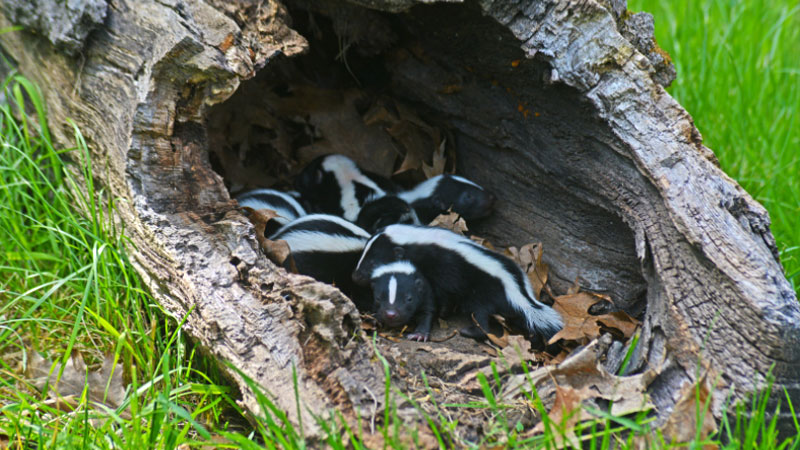
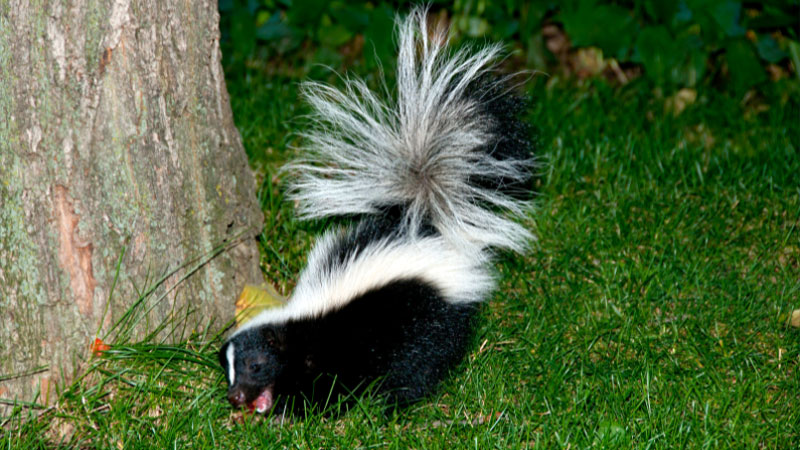
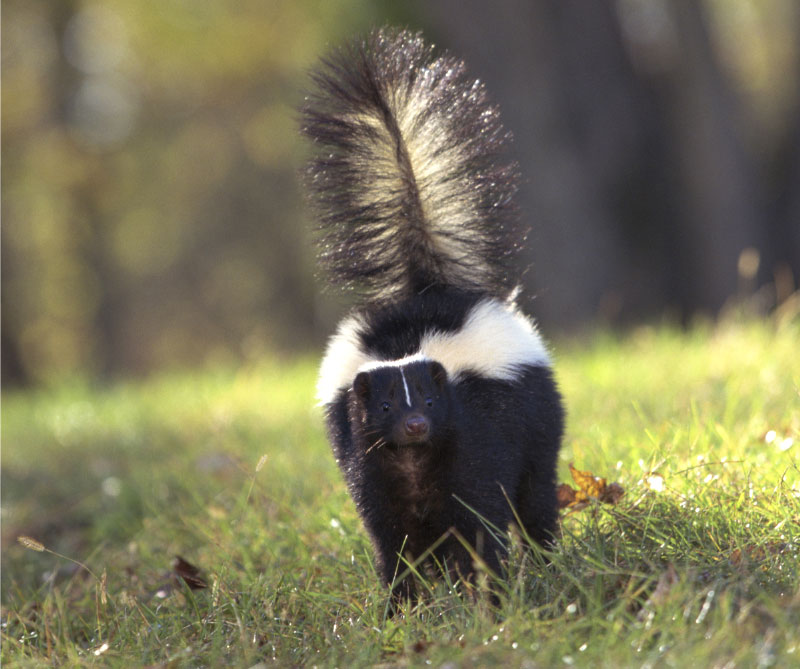
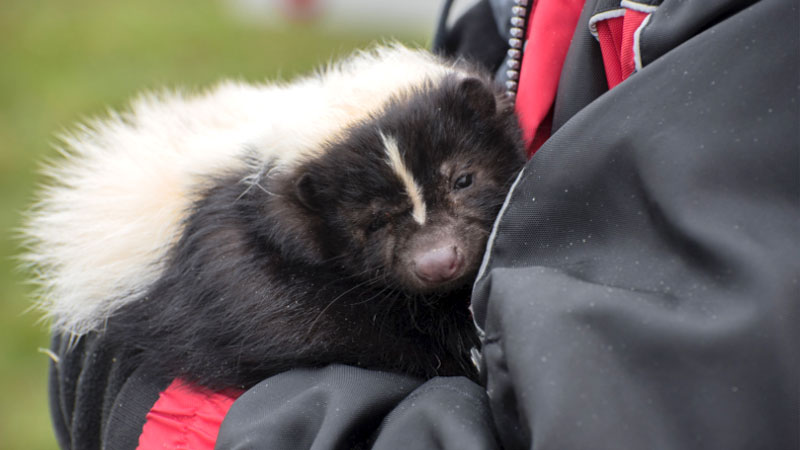
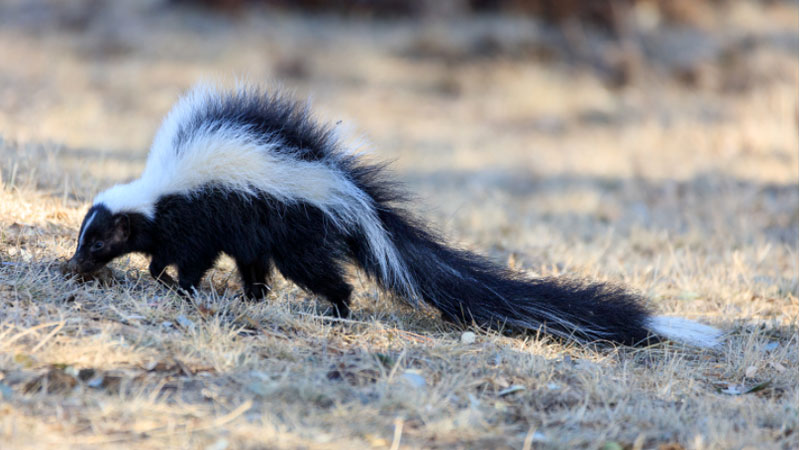
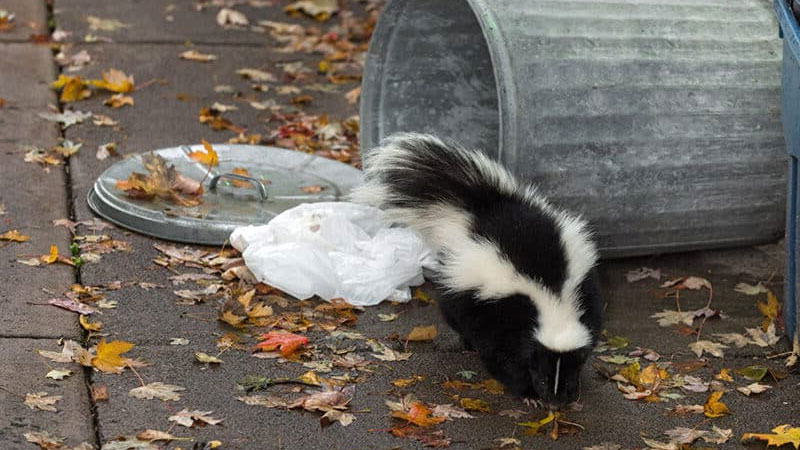
Thank you for the scope of information here. I especially appreciate your clearly compassionate and non-violent approach to managing these admirable creatures. Why admirable? Because they always prefer to remain peaceful so far as it rests with them, and because their defense is non-lethal. I do find your advice to those seeking to make the land they live on unattractive to skunks by ” treating your backyard for grubs ” & grasshoppers too, apparently, disturbing. The use of poisons should be discouraged except in very extreme circumstances. Even those labeled non-toxic, or ‘ safe ‘ are usually if not always no such thing. Other than this, though, Excellent work!!!